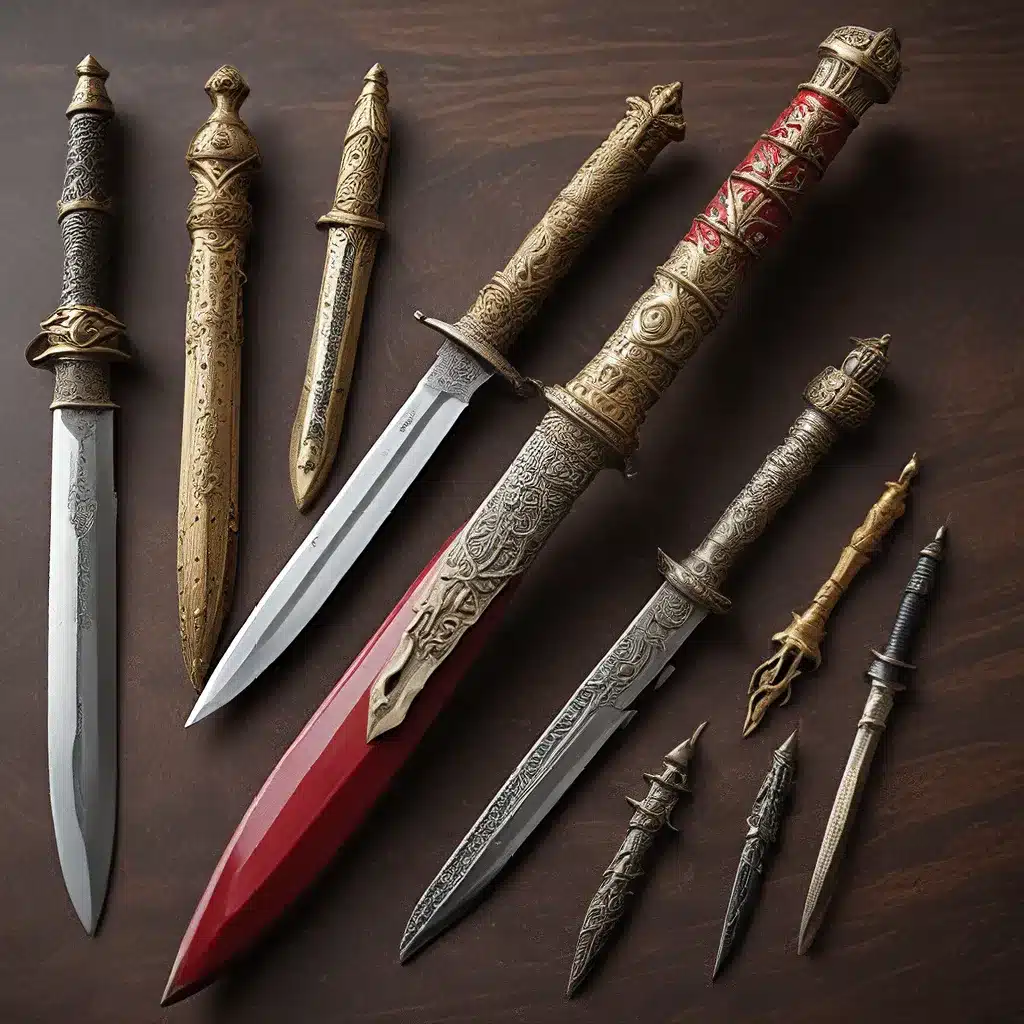
Tracing the Timeless Allure of Daggers
As I delve into the captivating world of daggers, I can’t help but feel a sense of awe and wonder. These compact yet formidable blades have captivated the human imagination for millennia, transcending their practical utility to become symbols of power, status, and cultural identity. From the ancient civilizations of Egypt, Greece, and Rome to the ornate ceremonial daggers of the Middle East and the sleek, modern tactical designs, the dagger’s evolution is a testament to our enduring fascination with these enigmatic tools.
The Dawn of the Dagger: Ancient Civilizations
Let’s start our journey by stepping back in time, to the dawn of human civilization. The earliest known daggers date back to the Copper Age, around 3500 BCE, when our ancestors first began experimenting with metalworking. These primitive blades, forged from copper or bronze, were often crudely crafted but nonetheless served as essential tools and weapons for self-defense, hunting, and ritual purposes.
As civilizations advanced, so too did the art of dagger-making. In ancient Egypt, the discovery of King Tutankhamun’s tomb in 1922 revealed a treasure trove of stunning artifacts, including a dagger forged from meteoritic iron. This remarkable find, dating back to the 14th century BCE, highlights the technological prowess of Egyptian metalworkers and the symbolic significance of these blades. The dagger, believed to be a gift from a foreign king, was likely viewed as a powerful omen, a testament to the Egyptians’ mastery of the elements.
Across the Mediterranean, the Greeks and Romans also embraced the dagger as a symbol of military might and personal honor. The Spartans, renowned for their fierce warrior culture, carried a distinctive curved dagger called the kopis, which they used both in battle and for ceremonial purposes. Meanwhile, the Romans incorporated the pugio, a double-edged dagger, into their legionary arsenal, valuing its versatility and deadly efficiency.
The Dagger in the Middle East: Grandeur and Ceremony
As the centuries passed, the dagger evolved to become a canvas for artistic expression and cultural identity, particularly in the Middle East. The Khanjar, a curved, single-edged dagger native to the Arabian Peninsula, became a beloved accessory among the region’s nobility and warriors. These daggers were often adorned with intricate designs, precious metals, and gemstones, reflecting the opulence and refinement of their owners.
In Persia, the Pesh-Kabz, a distinctive double-edged dagger with a curved blade, gained prominence as a symbol of power and prestige. These daggers were not only functional tools but also served as ceremonial objects, used in investiture ceremonies and diplomatic exchanges. The Pesh-Kabz’s elegant form and ornate decorations, which often featured motifs of lions, eagles, and calligraphic inscriptions, spoke to the region’s rich cultural heritage.
The Dagger in Asia: Mystique and Symbolism
Venture eastward, and you’ll discover the profound impact of the dagger on Asian cultures. In smaller countries with fascinating histories, the dagger has taken on a mythical quality, imbued with spiritual and symbolic significance.
In Japan, the tanto, a short sword with a distinctive blade, has long been revered as a mark of the samurai’s honor and discipline. These blades were not merely weapons but embodiments of the samurai’s code of bushido, representing their dedication to loyalty, courage, and unwavering resolve.
Across the Himalayas, the phurba, a three-bladed ritual dagger used in Tibetan Buddhist practices, has become a potent symbol of spiritual power and the transformation of negative energy. These daggers, often intricately carved with deities and mantras, are believed to possess the ability to vanquish evil spirits and obstacles on the path to enlightenment.
The Dagger in the Modern Era: Functionality and Innovation
As we move into the present day, the dagger has evolved to meet the demands of a rapidly changing world. While the ceremonial and symbolic aspects of these blades have not been forgotten, the modern dagger has also embraced a newfound emphasis on functionality and practicality.
In the realm of tactical and survival knives, the dagger has found a new niche, with designers and manufacturers pushing the boundaries of material science and ergonomic design. Sleek, lightweight blades crafted from advanced alloys and equipped with innovative features have become essential tools for military, law enforcement, and outdoor enthusiasts.
Yet, even in this age of high-tech innovation, the dagger’s timeless allure persists. Collectors and enthusiasts continue to appreciate the artistry and craftsmanship that goes into the creation of these iconic blades, whether they are modern interpretations or faithful reproductions of historical designs.
Conclusion: The Enduring Fascination with Daggers
As I conclude my exploration of the dagger’s captivating history, I am left with a profound sense of respect and wonder. These compact yet powerful blades have transcended their practical origins to become symbols of power, culture, and the human spirit. From the ancient civilizations of the past to the cutting-edge designs of today, the dagger’s enduring appeal is a testament to our enduring fascination with the tools we wield and the stories they have to tell.
Whether you’re a historian, a collector, or simply someone intrigued by the enduring allure of these enigmatic blades, the journey through the history of daggers is one that promises to surprise, delight, and inspire. So, let us continue to unravel the mysteries and marvels of these timeless artifacts, ever curious about the tales they have yet to reveal.


